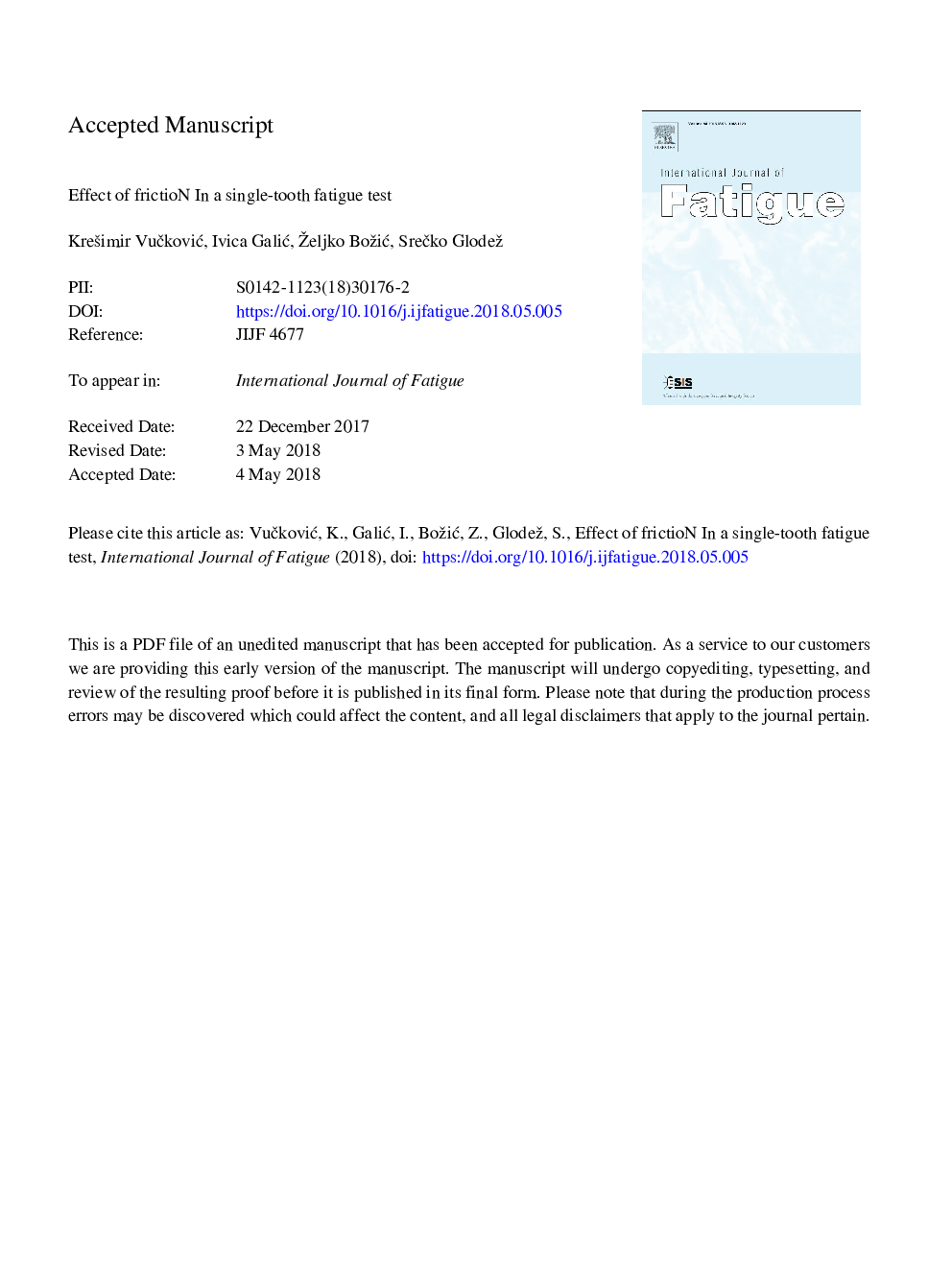| کد مقاله | کد نشریه | سال انتشار | مقاله انگلیسی | نسخه تمام متن |
|---|---|---|---|---|
| 7171385 | 1463708 | 2018 | 18 صفحه PDF | دانلود رایگان |
عنوان انگلیسی مقاله ISI
Effect of friction in a single-tooth fatigue test
ترجمه فارسی عنوان
اثر اصطکاک در آزمون خستگی تک دندان
دانلود مقاله + سفارش ترجمه
دانلود مقاله ISI انگلیسی
رایگان برای ایرانیان
کلمات کلیدی
دنده، آزمون خستگی تک دندان، اصطکاک، رویکرد روانشناختی، تجزیه و تحلیل عنصر محدود،
ترجمه چکیده
هدف اصلی آزمون خستگی دندان، تولید داده های خستگی دنده ای دندان در قیمت نسبتا پایین است. با در نظر گرفتن تاثیر ناچیزی بر داده های خستگی، اثر اصطکاک مورد ارزیابی قرار نمی گیرد. هدف از این مطالعه، ارزیابی اثر اصطکاک دندان بر خستگی خمش دندان و محل بستن محل بستر در یک آزمون خستگی دندانی در مورد چرخ دنده فولاد کاربوس شده است. با استفاده از قانون نیبر، تنش ریشه دندان با استفاده از تحلیل عناصر محدود الاستیک دو بعدی پیش بینی شده است که به برآوردهای تنش کشش کششی و رفتار کششی تبدیل می شود. عمر خستگی و محل شروع محل ترک در بر اساس رویکرد تنش عمر با در نظر گرفتن میانگین استرس، سطح پایان و اثرات استرس پسماند پیش بینی می شود. دو مدل بار در نظر گرفته شده اند. در مدل بار اول، که نشان دهنده اصل عملیاتی است که معمولا در عمل استفاده می شود، دندان تست از طریق بازو فعال می شود. در مرحله دوم، که در این مطالعه پیشنهاد شده است، دندان تست واکنش را از طریق لانه ثابت پشتیبانی می کند. در هر دو مدل بار، دندان تست در بالاترین نقطه تماس تک دندان تماس می گیرد، در حالی که یکی دیگر در یک موقعیت پایین در طول پروفیل دندان تماس می گیرد. مدل محاسباتی بر خلاف آغاز آزمایشی آزمایشی از ادبیات تأیید شده است. این تحقیق نشان داد که اصطکاک اثر بیشتری بر خستگی خمیدگی دندان و محل شروع ترک برای مدل بار اول دارد، در مقایسه با مرحله دوم.
موضوعات مرتبط
مهندسی و علوم پایه
سایر رشته های مهندسی
مهندسی مکانیک
چکیده انگلیسی
The primary objective of the single tooth fatigue test is to generate gear-tooth bending fatigue data at a comparatively low price. Assuming a negligible influence on fatigue data, the effect of friction is not evaluated. The aim of this study is to evaluate the effect of tooth friction on tooth bending fatigue life and on the location of the crack initiation site in a single-tooth fatigue test of case carburized steel spur gear. By using Neuber's rule, tooth root stresses predicted by means of two-dimensional elastic finite element analysis are translated into estimates of elastic-plastic stress and strain behaviour. The fatigue life and location of crack initiation site are predicted on the basis of the strain-life approach with consideration of mean stress, surface finish and residual stress effects. Two load models are considered. In the first load model, which represents the operating principle commonly used in practice, the test tooth is loaded through the actuating arm. In the second one, which is proposed in this study, the test tooth supports the reaction through the fixed anvil. In both load models, the test tooth is contacted at the highest point of single tooth contact, while the other one is contacted at a lower position along the tooth profile. The computational model is validated against experimental crack initiation lives from literature. The study revealed that friction has a more significant impact on tooth bending fatigue life and location of the crack initiation for the first load model as opposed to the second one.
ناشر
Database: Elsevier - ScienceDirect (ساینس دایرکت)
Journal: International Journal of Fatigue - Volume 114, September 2018, Pages 148-158
Journal: International Journal of Fatigue - Volume 114, September 2018, Pages 148-158
نویسندگان
KreÅ¡imir VuÄkoviÄ, Ivica GaliÄ, Željko BožiÄ, SreÄko Glodež,
